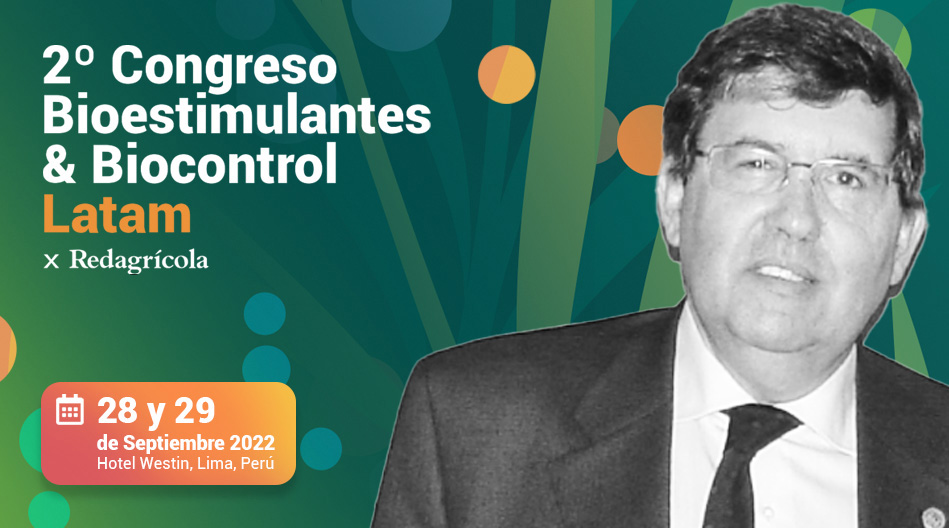“Cuántas veces hemos llegado a un restaurante y nos dicen que hay lista de espera, que no podemos comer porque no hay sitio. Es lo que pasa con el endofitismo”. Así explica el científico español Dr. Enrique Monte sobre el modo en que actúan hongos como el Trichoderma: ocupa el espacio en el suelo e impide que otros más nocivos para la planta ingresen.
Eso es una de las características que hacen del Trichoderma an effective plant promoter or biocontrol agent, becoming a microorganism of great value for agriculture. A very curious mechanism it has to perform biological control is endophytism, in which it occupies the places where pathogens could act, leaving them without space to attack.
Monte fue uno de los participantes de la 3era versión de las Series Online sobre Bioestimulantes & Biocontrol de Redagrícola, evento que sirve de preparación para el 2do Congreso de Bioestimulantes y Biocontrol que se realizará este 28 y 29 de septiembre en el Hotel Westin, de Lima, Perú.
En estos eventos about these issues and our Latin American Congress that will be held in Lima, han participado varios referentes mundiales y latinoamericanos del área de los bioinsumos, como el belga Dr. Patrick du Jardin, the American Dr. Patrick Brown, the German Nicolaus von Wirén, the Colombian Dr. Alba Marina Cotes and the Brazilian Wagner Bettiol. Muchos de ellos formarán parte del programa de dos días que se llevará a cabo en la capital peruana en septiembre.
El Dr. Enrique Monte, es profesor titular en el Departamento de Microbiología y Genética de la Universidad de Salamanca, y un referente global en estudios de Trichoderma. Figura en el ranking “World ‘s Top 2% Scientists” de la Universidad de Stanford, que considera a los investigadores con más influencia en su área a nivel mundial.
Dada su experiencia en el tema, el Dr. presentó su charla “Trichoderma: ¿Un agente de biocontrol que es bioestimulante o un bioestimulante que es agente de biocontrol?”, donde se refirió a los efectos de Trichoderma on plants, the mechanisms by which it develops biological control and biostimulation, among other topics.
Su presentación de 90 minutos la dividimos en seis partes con lso siguientes títulos:
- Características y evolución de trichoderma
- Efectos de trichoderma sobre las plantas
- Las claves que hacen del trichoderma un agente de biocontrol
- Potencial bioestimulante de trichoderma
- El curioso caso de la defensa sistémica inducida por trichoderma
- Ejemplos de estudios y conclusiones
Revise a continuación los videos donde el Dr Monte profundiza en las propiedades que hacen de este organismo uno de los socios mpas relevantes del agricultor en bpusqueda de mejores desemeños de sus campos.
1. CARACTERÍSTICAS Y EVOLUCIÓN DE TRICHODERMA
Dr. Monte provides an historical review of the main characteristics of this anamorphic mitotic microorganism. He also gives an account of its evolution, from its origins to the mechanisms of action that it developed to adapt better and better to different environments.
2. EFECTOS DE TRICHODERMA SOBRE LAS PLANTAS
Actualmente, Trichoderma is now known worldwide for three key interactions it performs with plants: direct biological control, indirect biological control and biostimulant. Dr. Monte explains each of these methods and emphasizes that biostimulant capacity is a trait spread throughout the genus and depends on the strain. He also highlights the importance of choosing the correct strain of the fungus according to the intended effect.
3. ¿POR QUÉ TRICHODERMA ES AGENTE DE BIOCONTROL?
A través de su evolución,Trichoderma began to capture hydrolytic enzymes from the fungi it parasitized in order to improve its own machinery, in a mechanism known as mycoparasitism. It also acts with enzymes that degrade the cell wall of the pathogens or inhibit their enzymes, confusing their mechanism of attack and preventing them from affecting the plant.
4. POTENCIAL BIOESTIMULANTE DE TRICHODERMA
As a way of answering the initial question of his presentation, Dr. Monte refers to the biostimulant potential of the fungus. When there are no pathogens for Trichoderma deba controlar, comienza a colonizar las raíces de la planta y la ayuda a crecer. El doble beneficio para el vegetal es que no debe usar energía para defenderse y la puede destinar a su crecimiento.
5. EL CURIOSO CASO DE LA DEFENSA SISTÉMICA INDUCIDA POR TRICHODERMA
This strategy is considered primarily as biological control and not biostimulation, but they are closely related to each other. After clarifying this, the professor points out that when this defense is against pathogens, it is considered biological control, while if it is against abiotic stress, it is biostimulation.
6. EJEMPLOS DE ESTUDIOS Y CONCLUSIONES
To conclude, the professor exposes several examples of research where Trichoderma ayuda a plantas a adaptarse a distintos tipos de estrés ambiental a través de diferentes estrategias. Las respuestas que genera el hongo son ondulantes y en función del momento en que se analicen las defensas de la planta, será mejor elegir una u otra.

